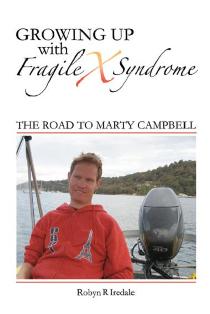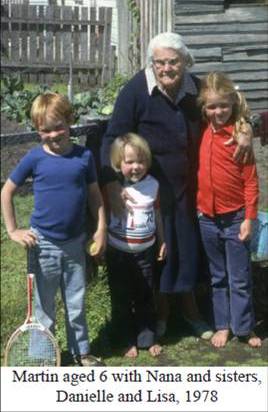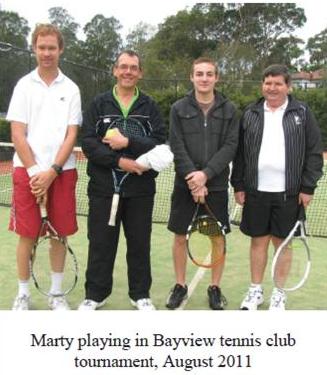September 25 - October 1, 2011: Issue 25
Book launch for Growing Up with Fragile X Syndrome at the Gone Fishing Gallery, Pasadena, Church Point Saturday 29 October, 4pm – 6pm
 Growing up with Fragile X Syndrome: The Road to Marty Campbell is the new biography from long time Scotland Island resident, Robyn Iredale.
Growing up with Fragile X Syndrome: The Road to Marty Campbell is the new biography from long time Scotland Island resident, Robyn Iredale.
Robyn is launching her story of raising a son affected by fragile X (FX) and invites those living in the Pittwater area and who work in health and disability services, or who have a personal connection to or interest in fragile X, to attend.
FX syndrome is the leading cause of inherited intellectual disability and the most common known genetic cause of autism. It is found in all races and at all socio-economic levels. Latest statistics indicate 1 in 3600 males and 1 in 4000- 6000 females are affected and that as many as 1 in 280 males and 1 in 125 females are carriers. Every week in Australia one child is born who is fully affected and twelve children are born who are carriers.
Dr Iredale’s book describes her extended family’s journey along the FX road from Marty’s pre-diagnosis at age seven back in 1977, when awareness and support services were essentially non-existent, through the trials and the triumphs of school, sport and employment, to the present.
It also includes vital FX research and information on testing, health issues, education, behavioural challenges, likely outcomes for carriers versus those affected and describes with humour the many common personality traits shared by those affected, which will resonate with families touched by FX.
There have been plenty of academic books and research papers written on FX but it is believed The Road to Marty Campbell is the first personal account available worldwide.
Launch speakers:
Dr Paolo Totaro AM
John Kelleher, Fragile X Association of Australia President
Dr Robyn Iredale, author
The book’s main subject, Marty Campbell, will attend the launch.
RSVP by 24 October to Robyn via email robyn.iredale@anu.edu.au or ph. 9979 1096 Complimentary refreshments will be supplied.
For information on fragile x and to order a copy of Growing up with Fragile X Syndrome go to http://www.fragilex.org.au/ or download file below

|
ORDER FORM.pdf Size : 7.765 Kb Type : pdf |



Copyright Robyn Iredale, 2011.
All Rights Reserved.
The writing of ‘Growing Up with Fragile X Syndrome: The Road to Marty Campbell’
by Dr Robyn Iredale
Marty is my 39-year old son and he is a pre-mutation Fragile X (FX) carrier. The name of the syndrome comes from its location on the X chromosome, where the bottom of the long arm of this chromosome can appear broken or fragile(1). Since 2005 both the United States National FX Foundation and the Fragile X Association of Australia (FXAA) have adopted a new classification of the whole suite of FX disorders, known as Fragile X-associated Disorders (FXDs). This includes the following three key categories:
• Fragile X Syndrome (FXS)—the most common cause of inherited intellectual disability, behavioural disorders and speech and language delays that manifest in early childhood;
• Fragile X-associated tremor/ataxia syndrome (FXTAS) which occurs only in FX pre-mutation carriers—a neurological disorder which sets in at 50 or over, causing tremors, balance and memory problems, and cognitive decline;
• Fragile X-associated primary ovarian insufficiency (FXPOI) which occurs in carrier women only—causing irregular menstrual cycles, infertility and premature menopause in females.
The above classification may imply that pre-mutation individuals may only affected by FXTAS and FXPOI. However, pre-mutation FX carriers can experience cognitive, behavioural and social disorders. A fourth dot point, and one where Marty falls, should be added.
• Pre-mutation Fragile X (PMFX)—more common that FXS and can include intellectual disability, behavioural disorders and development delays that are often less obvious than for FXS.
The writing of this book was Marty’s idea. Most of my immediate family are writers, in some form or other, and Marty has seen us constantly working away on our computers. Tim and I are academics, Marty’s elder sister, Lisa, is a media/public relations consultant and Danielle, his younger sister, is a community development manager with the Central Land Council in Alice Springs.
Marty would repeatedly ask us why we did not write a book about him. I resisted for some time suggested to another woman who has a FX grandson and who is a widely-published author that she should do it. She told me that she ‘could not as it would be too painful’. In 2003 I started to take Marty more seriously and to realise that what he was really wanting was affirmation that his life and achievements merited as much attention as our work. When I started writing he was Martin Dennis Smith but by the time I had finished, in 2011, he had changed his name to Marty Campbell—hence the title.
The process of writing was hard and one that we all shied away from for some time. I commenced on a number of chapters and I thought that I would keep to the positives and skate lightly over many of the struggles and difficulties. Marty was insisting on reading the book at this stage, so I trod carefully. I also wanted to minimise the pain. By asking Lisa and Danielle, Tim, Xiang Biao (a Chinese student who lived with Marty while he was doing his PhD), Cristina Cesaro (a teacher friend of Lisa’s) and June Wilson (Marty’s babysitter when he was young) to write a chapter each I thought I could gain different perspectives and not go too deeply myself.
Tim joined in enthusiastically and wrote several chapters on his insights since coming to live with Marty when he was 19 years old. He could be more dispassionate as he had not been part of the early years, but still he found it a challenge as he struggled with Marty’s idiosyncracies.
Lisa and Danielle found writing about their experiences a major challenge but gave each other the strength to persevere. Part of this relates to their own difficulties, as young children and then young women, in dealing with the dynamics of having a single mother, a non-participating father and a brother with FX. Writing their pieces exposed many hurts and struggles and was a very difficult process for them. They both found it hard to focus on the positive elements, given that the negatives loomed so large when they were young. At one point I wrote the following as part of a letter to them both to try to enduce them to write:
It is not a book like Siblings that is written about the nature of siblings’ relations with their affected person. I think there is room for some of this but it is not its predominant theme. In this aspect I think we need to focus on the support, riddled with tensions, you both gave him. In the absence of a supportive father you both probably tried to compensate for this and to mother/father him as well. He knows he missed out on a loving father…
Dan’s letter about how she grew up with him and the difficulties as well as the fun times will help people to see what a sibling experienced – albeit one who was caring and supportive but who also had her own life to live. It also shows how you included him and then excluded him when the teenage years hit. This is not surprising at all but in adulthood you see it differently.
For Lisa I think the task was harder as the job was harder. So much responsibility was cast onto you – probably too much for a pre-teenager. … (Robyn Iredale, 2005)
This book is really the first chance that my daughters have had to get things out into the open and try to be honest. In retrospect I think they can now understand how and why they felt as they did and I hope that the book has positive benefits for both of them. Their comments are particularly important because they draw attention to the sacrifices, usually unrecognised, that need to be made if a FX sibling is to achieve a relatively normal life.
After I showed the first draft to a publishing agent she suggested that it be rewritten from my perspective, as Marty’s mother. I found this daunting at first but after some months set about redoing it. This meant drawing on the chapters that others had written and expanding my own accounts of major periods in Marty’s life. For me it has been a chance to put many things down on paper that have been occupying much of my time and thoughts for many years. It has also given me a chance to think about the implications of FX for all members of our family and those that came into contact with.
Aside from immediate family members, many other people have contributed to this book in various ways. Xiang Biao, the Chinese anthropologist who lived with Marty for 18 months in 2000-01 wrote of his experiences of living with Marty and this provides a fascinating insight. June Wilson, Marty’s babysitter from the time he was 2 to 5 and a long time friend, agreed to interview Marty and ask him about his feelings, concerns and joys. She spent a month with Marty in June-July 2008, while I was away, and used this opportunity to talk to him about lots of issues, especially how he felt and what he found most difficult and most rewarding.
So, for all of us, it has been a chance to explore our experiences and feelings and hopefully for all to benefit. It is a story about Marty and what it means to be in a fragile X family. I felt that there has been so little written about FXS, and intellectual disability in general, that there was room for a book such as this.
(1.): It has been estimated that, worldwide, 50% of people affected by fragile X have not been correctly diagnosed.